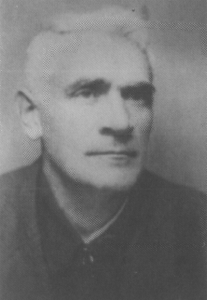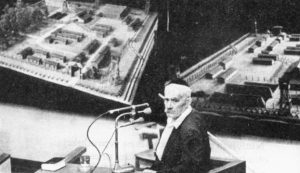Jankiel Wiernik – T2 prisoner

Jankiel Wiernik was born in 1889 in Biała Podlaska. He was a qualified carpenter. Before the war, he worked as the administrator of a house belonging to Stefan Krzywoszewski – a writer and director of the City Theaters and the National Theater in Warsaw. On August 23, 1942, during the Grossaktion Warschau – liquidation of the Warsaw Ghetto, Wiernik was sent to the Treblinka II Extermination Camp. He avoided immediate death in the gas chambers, because during the turmoil of the arrival of the new transport, he got to the commando working on the segregation of looted property.
People stood and worked far away from us. They were putting packages that were unloaded from the train. I crept in between employees.
Jankiel Wiernik, Rok w Treblince, Warszawa 2003, p. 14.
The drilling rig was initially assigned to a commando working on moving corpses from gas chambers to pits. During his stay in Treblinka, he was noticed that he was highly qualified as a carpenter, and from then on he performed contracted construction works. Satisfactory results of his work provided him with some consideration in some SS-men and freedom of movement around the whole camp. Wiernik witnessed the deaths of hundreds of thousands of people who came to the Extermination Camp, he learned the whole mechanism of this place.
Once while laying the corpses on the grate, a raised up hand was noticed. All fingers were contracted, only the index was stiff and stuck high as if to the court of God calling its torturers. […] Even our executioners paled and did not take their eyes off this terrible sight. As if there really was a higher power in it. This hand stuck out for a long, long time. Part of the hearth has already incinerated, and here this hand stretched out towards the sky calls for justice. This minor, insignificant accident spoiled the mood of all murderers for a few moments.
Jankiel Wiernik, Rok w Treblince, Warszawa 2003, p. 31.
The opportunity to move freely around the camp was a valuable asset. Jankiel Wiernik quickly became a member of the underground conspiracy, whose purpose was to provoke the uprising and escape of prisoners staying at the Extermination Camp. On August 2, 1943, a uprising broke out in Treblinka. Wiernik found himself in a group of a few who escaped from the camp and lived to see the end of the war. After reaching Warsaw, he was helped by the Krzywoszewski family (with whom he worked before the war). Under the assumed name, he joined one of the units fighting in the Warsaw Uprising. In 1949 he emigrated from Poland to Sweden to finally settle permanently in Israel.

After the war, as a witness, he testified in the trial in 1947 against Ludwig Fischer – the governor of the Warsaw District General Governorate, and in 1961 he witnessed the prosecution against Adolf Eichmann.
He is also the author of one of the first accounts about the camp “A Year in Treblinka” published in the form of a brochure as early as 1944.
During the unveiling ceremony of the Monument to the Victims of the Death Camp in Treblinka on May 10, 1964, Jankiel Wiernik was one of the guests of honor. He died in 1972 in Israel.
Photos were taken from Jankiel Wiernik’s book “A Year In Treblinka” and Jechiel Rajchman’s book “The Last Jew of Treblinka: A Memoir”.
Translation: B.K.





